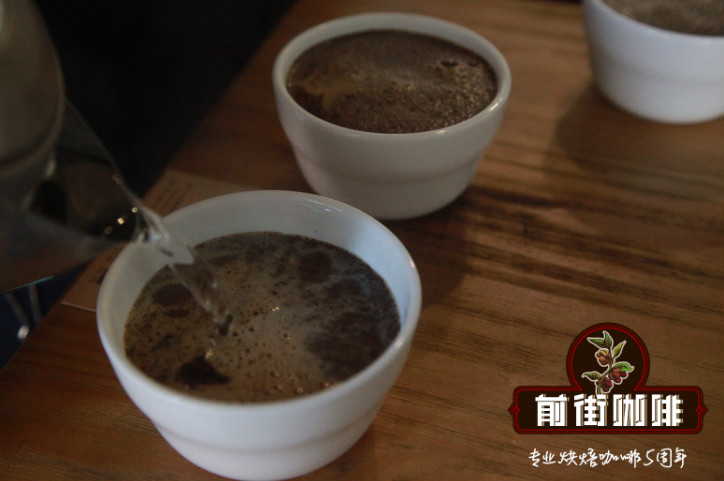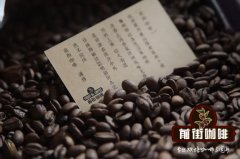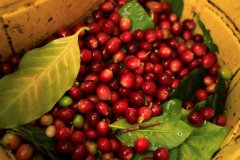How's the Sumatra mantinin? What are the characteristics of Sumatra mantinin coffee?

Professional coffee knowledge exchange more coffee bean information please follow the coffee workshop (Wechat official account cafe_style)
The gentleman in coffee, Sumatra Manning, is a fine coffee bean growing in the original mountain area at an altitude of 750 murmur1500m.
In the 17th century, the Dutch first introduced Arabica saplings to Ceylon (present-day Sri Lanka) and Indonesia. In 1877, a large-scale disaster hit the Indonesian islands, coffee rust destroyed almost all the coffee trees, people had to give up Arabica, which had been in operation for many years, and introduced the disease-resistant Robusta coffee tree from Africa. Indonesia today is a big coffee producer. Coffee is mainly produced in Java, Sumatra and Sulawi, with Robusta accounting for 90% of the total production. Sumatra Manning is a rare Arabica species. Planted on hillsides between 750m and 1500 m above sea level, the mysterious and unique Sumatran species give Mantenin coffee a rich aroma, rich taste, strong flavor, slightly chocolate and syrup flavor. Mantenin coffee beans have large granules and hard beans, and they are prone to defects in the process of planting. After harvest, they are usually subject to strict manual selection. If the control process is not strict enough, it is easy to cause a mixture of good and bad quality. in addition, the different degree of baking will also directly affect the taste, so it has become a more controversial single product.
The most famous producers of coffee in Asia are the islands of Malaysia: Sumatra, Java and Gary Mann.
Sumatra manning coffee from the Indonesian island of Sumatra is the most famous, it has two famous names, Sumatra mantenin DP first class and collection Sumatra mantenin. Sumatra Mantenin DP has a long aftertaste, with a hillside fragrance, which is unique to the earthy taste of the primeval forest. In addition to the mellow taste of Indonesian coffee, there is also a bitter sweet taste, sometimes mixed with a touch of mildew, which is popular with people who like to drink concentrated roasted coffee. Sumatran Mantenin coffee is called "classic" because it is stored in the cellar for three years before export. But the collection coffee is not old coffee, but slightly pale coffee through special treatment, this kind of coffee is more full-bodied, the acidity will decrease, but the mellowness will increase, the finish will be longer, and will bring a strong spicy flavor, sometimes sour, sometimes walnut, sometimes chocolate. Before Blue Mountain Coffee was discovered, Manning was regarded as the best coffee.
Manning's unique wet planing method
Wet planing, also known as wet shelling Wet Hulling, also known as Giling Basah in the local language, is a traditional Indonesian coffee treatment. Judging from the name alone, the wet planing method is very similar to the wet treatment (water washing treatment). However, the cup flavor of the two treatments is very different. The coffee treated by the wet planing method is usually mellow and strong, and the personality is very distinct.
Steps of wet planing treatment
① removes peel and pulp and retains parchment and mucous membrane.
② tank fermentation
③ washing off mucous membrane
④ with parchment is sun-dried for 2-3 days to 20-24% moisture content.
⑤ scraped off the parchment
⑥ dries raw beans to 12-13% moisture content.
⑦, prepare for exit.
Why do you use wet planing?
a. Climatic reasons
The tradition of using wet planing in Indonesia starts with the local weather. Humidity in Indonesia is between 70 and 90 percent all year round, typhoons continue, and in some areas, annual rainfall can reach as much as 2000mm. You know, raw beans are most afraid of Rain Water. How did Indonesia overcome such bad weather conditions to produce rich and mellow Mantenin coffee? That is to rely on wet planing.
In tropical climates, coffee takes an average of 2-3 weeks to dry. In such a humid climate in Indonesia, dry coffee has become a big problem. Coffee must take longer to dry, during which time the coffee still maintains a high humidity, making it easier for bacteria to soak into raw coffee beans.
In the process of ordinary washing, the drying process is carried out with parchment to protect raw beans from external damage to a certain extent. However, we can note that the wet planing removes the parchment for the final step of drying, so that the sun shines directly on the surface of the raw beans, causing the coffee beans to dry quickly, 2-3 times faster than washing.
b. economic performance
In the 17th century, Dutch colonists first introduced coffee to Indonesia. This group of colonists sought more and faster economic returns. Wet planing greatly shortened the time spent on the farm and greatly reduced the cost of labor. This coincides with the mentality of investors who pursue quick profits and reduce costs. This is also a reason to promote the wet planing method.
c. Defects and kuku kambing (Bauhinia)
When the parchment is removed by wet planing, the water content of coffee is still as high as 20-24%, while in general treatment, the water content of coffee is reduced to 10-12% before shelling. In the "semi-dry" state, parchment will adhere to the surface of raw beans, removing parchment is more difficult than "fully dry", and the shelling process requires more friction.
But on the other hand, "semi-dry" raw coffee beans are very fragile at this time, far less hard than "fully dry" raw beans, so beans are more likely to be squeezed and form a small gap. This is what we often call horseshoes or sheep's hoof beans (locally known as kuku kambing).
Important Notice :
前街咖啡 FrontStreet Coffee has moved to new addredd:
FrontStreet Coffee Address: 315,Donghua East Road,GuangZhou
Tel:020 38364473
- Prev

Taste and Flavor characteristics and treatment of Indonesian Sumatra Coffee Bean and Mantenin Coffee Bean
Professional coffee knowledge exchange more coffee bean information please pay attention to the coffee workshop (Wechat official account cafe_style) the world's largest archipelago country Indonesia, the country has more than 400 volcanoes, of which more than 1/3 active volcanoes, accounting for about 16% of the world, but Rakuten residents do not care, and volcanic symbiosis has become a unique local special culture.
- Next

Kenya Coffee Grade AA introduction _ Kenya Coffee Bean yield and quality Baking recommendations
Professional coffee knowledge exchange more information about coffee beans Please follow the coffee workshop (Wechat official account cafe_style) when it comes to coffee production, Kenya has always had a reputation for excellence in quality. This may have something to do with its geographical location, after all, close to the birthplace of coffee beans. Since coffee beans have traveled from Ethiopia through the mountains to Kenya, Kenya has become
Related
- Detailed explanation of Jadeite planting Land in Panamanian Jadeite Manor introduction to the grading system of Jadeite competitive bidding, Red bid, Green bid and Rose Summer
- Story of Coffee planting in Brenka region of Costa Rica Stonehenge Manor anaerobic heavy honey treatment of flavor mouth
- What's on the barrel of Blue Mountain Coffee beans?
- Can American coffee also pull flowers? How to use hot American style to pull out a good-looking pattern?
- Can you make a cold extract with coffee beans? What is the right proportion for cold-extracted coffee formula?
- Indonesian PWN Gold Mandrine Coffee Origin Features Flavor How to Chong? Mandolin coffee is American.
- A brief introduction to the flavor characteristics of Brazilian yellow bourbon coffee beans
- What is the effect of different water quality on the flavor of cold-extracted coffee? What kind of water is best for brewing coffee?
- Why do you think of Rose Summer whenever you mention Panamanian coffee?
- Introduction to the characteristics of authentic blue mountain coffee bean producing areas? What is the CIB Coffee Authority in Jamaica?

